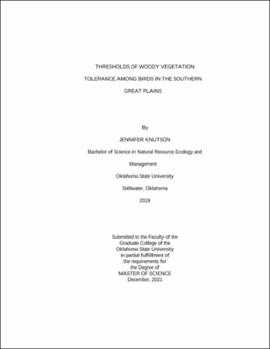| dc.contributor.advisor | Davis, Craig | |
| dc.contributor.author | Knutson, Jennifer | |
| dc.date.accessioned | 2022-05-13T19:05:14Z | |
| dc.date.available | 2022-05-13T19:05:14Z | |
| dc.date.issued | 2021-12 | |
| dc.identifier.uri | https://hdl.handle.net/11244/335771 | |
| dc.description.abstract | Across the globe, grasslands are experiencing a loss of ecosystem services due to numerous threats, such as overgrazing, agriculture intensification, and woody plant encroachment. In North America, an estimated 20% of grasslands remain intact, but even these areas are threatened by encroaching woody vegetation. Degradation of grasslands are a primary reason that 73% of grassland birds in the Great Plains are experiencing population declines. Although the threat of woody plant encroachment is well known to conservationists, current management practices have not been successful in reversing the trend over broad areas. That is due in part to the treatment of all woody plants as encroaching and equally detrimental. A few studies have already linked the structural characteristics of woody plants to their impact on the landscape. In this study, we investigated how western Oklahoma birds are utilizing woody plants on the landscape, if the height of the woody plant alters their use, and identified the woody vegetation tolerance threshold of these bird species. We conducted point counts at four Wildlife Management Areas in western Oklahoma followed by vegetation sampling during the breeding season 2018-2020. We analyzed species habitat use and identified thresholds in species abundance and frequency using three different height classes of woody vegetation to determine if different woody plant structures on the landscape alter the responses of grassland birds. We sampled 1,129 points and had 3,639 detections from 87 bird species. Analysis showed that woody vegetation height, in particular the abundance of taller trees, was a primary driver of the bird community structure in western Oklahoma grasslands. We found a multitude of woody vegetation tolerance thresholds across our sampled species highlighting the need for heterogeneity in the southern Great Plains. In addition, we identified bird species that responded positively and negatively to increased woody vegetation on the landscape. These results suggest that not all woody vegetation is the same and should not be considered equal when developing management strategies. We recommend further threshold analysis be used to create regional conservation plans that take into consideration the positives and negatives of woody plants for bird and other wildlife communities and highlight the need for a heterogenous landscape. | |
| dc.format | application/pdf | |
| dc.language | en_US | |
| dc.rights | Copyright is held by the author who has granted the Oklahoma State University Library the non-exclusive right to share this material in its institutional repository. Contact Digital Library Services at lib-dls@okstate.edu or 405-744-9161 for the permission policy on the use, reproduction or distribution of this material. | |
| dc.title | Thresholds of woody vegetation tolerance among birds in the southern Great Plains | |
| dc.contributor.committeeMember | Fuhlendorf, Samuel | |
| dc.contributor.committeeMember | O'Connell, Timothy | |
| osu.filename | Knutson_okstate_0664M_17390.pdf | |
| osu.accesstype | Open Access | |
| dc.type.genre | Thesis | |
| dc.type.material | Text | |
| dc.subject.keywords | bird community | |
| dc.subject.keywords | great plains | |
| dc.subject.keywords | thresholds | |
| dc.subject.keywords | tolerance thresholds | |
| dc.subject.keywords | woody encroachment | |
| thesis.degree.discipline | Natural Resource Ecology and Management | |
| thesis.degree.grantor | Oklahoma State University | |
